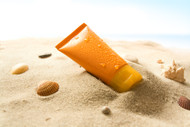How to Remove Sunscreen from Leather
Posted by Daniel Sutton on Oct 20th 2014
If you've ever gone to the beach, chances are you've had a mishap with sunscreen. This stuff is amazing on human skin, but on everything else, not so much. Leather in particular. If your leather's suffered from sunscreen, chances are you're encountering some sticky residue on the surface, and perhaps a dark spot if it's had time to set. Word of advice: don't let it set. Leather will absorb almost anything it touches, regardless of whether it's good for it or not.
So the first step will always be to blot. Blot up as much sunscreen as you can with a soft cloth. Don't wipe here, or else you'll just be smearing the sunscreen back in. After the residue's gone as much you can get it, you'll want to use that handy ubiquitous corn starch that's somewhere in your pantry. Take your time trying to find it (we've got pantries too!). In case it doesn't show up, baking soda also makes a killer substitute.
Before you sprinkle the powder on, try to rub your leather. As you rub, friction builds up, which heats and loosens the lotion trapped within the leather's pores. As an alternative, you can lightly touch up the surface with a slightly damp, warm rag. Blot up any moisture, and continue. Sprinkle your powder over the surface and let it set for a night. Corn starch and baking powder contain very absorbent properties that can actually pull contaminants out of leather's surface when they set long enough. If your powder turns yellow in the morning, you'll know your mission was a success.
Plan B
If the powder did turn yellow, but there's still a spot, you could try the procedure again. However, chances are you may need to try something with a bit more punch. Corn starch is good for picking up contaminations near the leather's surface, but in order to pull out deeper stains, you will need a deeper cleaner. We at Chamberlain's have a recipe just for that purpose - Straight Cleaner, an alcohol-based cleanser specially formulated to strike at those nasty blemishes that get under your leather's skin.
As with all leather treatments, you will want to test Straight Cleaner first. Straight Cleaner is designed to work on most leather types, but the most fundamental rule of all leather care is that no two leather pieces are the same. There are infinite varieties of leather out there and infinite ways they can be tanned, cut, dyed, finished, or dressed. Your leather is unique, and it will require unique care. Get to know what it likes best through continued treatments. If Straight Cleaner has not been used on your leather before, apply it in a discreet area and check its results after drying. If you are satisfied, give the leather an even, thin layer of Straight Cleaner, and then brush off any residue. Allow the leather to dry in a cool, clean area away from sunlight and direct heat.
By The Way
Another important thing about leather care: always follow up deep cleaners with leather conditioner. While these cleaners will take out a lot of bad stuff, they also take out some good stuff with them, such as the natural oils that keep your leather soft and supple. We recommend Leather Care Liniment to restore these vital nutrients. Or in the more likely circumstance, since we're dealing with sunscreen here, Auto Refreshener No. 4, for automobiles or leather that gets way too much sun exposure.
Test your leather conditioner first like you did with Straight Cleaner, and apply in similar thin, even layers. Only give the surface as much conditioner as it will absorb. If you've given it too little, you can always put on another layer. If too much has been applied, however, it can clog up the leather's pores and leave you a sticky residue similar to the kind you were trying to fix in the first place. Wipe the conditioner off with a damp cloth if this happens - it shouldn't be as difficult to pull out as the sunscreen. After the leather's had as much conditioner as it can eat, buff off the rest and leave it in your usual drying place to set overnight. Bonus: this conditioner also gives your leather a layer of protection for next time!
Voilà!
Hopefully that did the trick for you. It may take a few clean & conditioning routines to fully bring the sunscreen out. Have patience with it, and remember to take care of your leather. It may be a good idea to set towels on your leather seats next time you hit the beach, or perhaps to clean off beforehand. Whatever you can do to give your leather protection. It's got a life of its own, after all. Don't believe me? Check out our other article: How Does Leather Breathe?
Hope this helps!
Contributors:
Daniel Sutton

